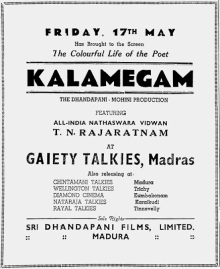Kalamegam
| Kalamegam | |
|---|---|
 Theatrical release poster | |
| Directed by | Ellis R. Dungan William J. Moylan |
| Written by | Puduvai Bharathidasan |
| Starring | T. N. Rajarathnam S. P. L. Dhanalakshmi N. S. Krishnan T. A. Madhuram Kali N. Rathnam |
| Cinematography | V. Namasivayam |
| Edited by | R. S. Mani |
| Music by | R. N. Chinnaiah |
Production companies | Sri Dhandapani Films Salem Mohini Pictures[1] |
Release date |
|
| Country | India |
| Language | Tamil |
Kalamegam is a 1940 Tamil-language film directed by Ellis R. Dungan and starring nadaswaram player T. N. Rajarathnam Pillai. This was the second film as script writer for the Tamil rationalist poet Bharathidasan. This was the only film in which Pillai acted in his life.[3][4][5][6][7]
Plot[edit]
This article needs an improved plot summary. (July 2022) |
Kalamegam is based on the life of 15th century Tamil poet Kalamegam.
Cast[edit]
|
|
- Support cast[1]
R. S. Ramu, Natarajan, M. A. Pichai Pandurar, T. Thangaiah, A. Sivakozhundhu, C. G. Nammazhvar Reddiar, Ramasami Pillai, and Sundarabhashyam Naidu.
Production[edit]
Dungan was hired to direct a film based on the life of the 15th century Tamil poet Kalamega Pulavar. Nadaswaram Maestro T. N. Rajarathnam Pillai was cast in the title role as poet Kalamegam. The script was written by the rationalist poet Puduvai Bharathidasan. To satisfy Rajarathnam Pillai's fans, scenes with Kalamegam playing the Nadaswaram were added to the film. Dharmapuri S. Murugesan who was one sixth partner of Mohini Pictures acted as the Raja Thirumalia Naiker in front of whom TNR played the nadhaswaram. C.V.V Panthulu and another minister were sitting in the dharbar. S. P. L. Dhanalakshmi was cast as Mohangi and the comedy parts were played by N. S. Krishnan, T. A. Madhuram and Kali N. Rathnam. According to the Kalamegam legend, he cursed a village to be destroyed in a sandstorm. Dungan filmed some of the sandstorm scenes on location and shot the remaining scenes using large sized miniatures constructed on the Elliot's Beach in Madras. The completed film was 18,986 feet in length. The film was produced at Prag Jyothi Motion Pictures.[1][3][4]
Songs[edit]
The music was composed by R. N. Chinnaiah and the lyrics were written by Puduvai Bharathidasan.[1][4]
- Orchestra[1]
- R. N. Chinnaiah – Harmonium
- M. V. Santhanamaiah – Harmonium
- V. Govindasami – Fiddle
- R. N. Thambi – Veena
- K. V. Naidu – Mridangam
- C. Kuppusami Naidu – Clarinet
- Sadhu Ganapathi Sastri – Jalatharangam
- Bande Khan Saheb – Sarangi
- J. Ramakrishna Rao – Organ
- Nagaiah – Flute
- T. S. Mani – Bulbulthara
- N. Parthasarathy Naidu – Saxophone
Reception[edit]
The film was released on 17 May 1940 and was a box office failure. But the sandstorm scenes were well received by the audience. The film is lost, with the only known surviving artefacts being stills and 78 rpm-song discs.[3]
References[edit]
- ^ a b c d e f g "Pavendarin Kalamegam". InternetArchive (in Tamil). Retrieved 20 May 2020.
- ^ "Kalamegam". The Indian Express. 18 May 1940. p. 2.
- ^ a b c Guy, Randor (21 September 2007). "Kalamegham 1940". The Hindu. Archived from the original on 10 February 2020. Retrieved 10 February 2020.
- ^ a b c Film News Anandan (2004). Sadhanaigal padaitha Tamil Thiraipada Varalaaru (in Tamil). Chennai: Sivagami Publications. pp. 28:20.
- ^ Baskaran, S. Theodore (1996). The eye of the serpent: an introduction to Tamil cinema. Chennai: East West Books. p. 180.
- ^ Rajadhyaksha, Ashish; Willemen, Paul, eds. (1998) [1994]. Encyclopaedia of Indian Cinema (PDF). Oxford University Press. p. 88. ISBN 0-19-563579-5.
- ^ Narayanan, Arandhai (2008). Arambakala Tamil Cinema (1931-41) (in Tamil). Chennai: Vijaya Publications. p. 106.
